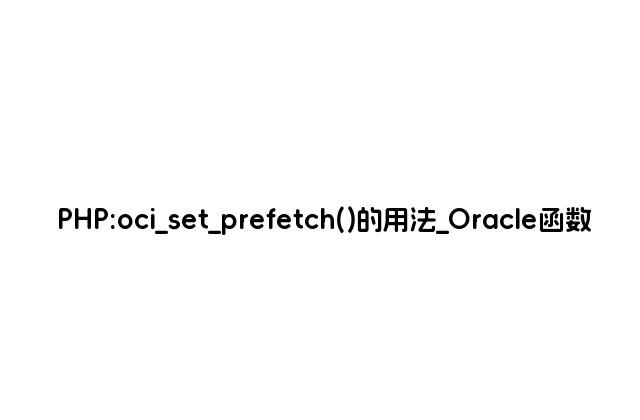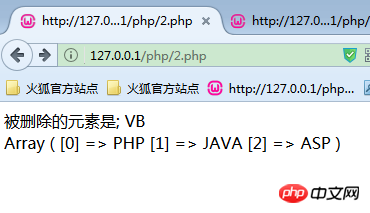
(PHP 5, PECL OCI8 >= 1.1.0)
oci_set_prefetch — 设置预提取行数
说明
bool oci_set_prefetch ( resource$statement
[, int $rows
] )
在成功调用 oci_execute()
之后设定预提取的行数。rows 的默认值为 1。
Note:
在 PHP 5.0.0 之前的版本必须使用 ocisetprefetch() 替代本函数。该函数名仍然可用,为向下兼容作为 oci_set_prefetch() 的别名。不过其已被废弃,不推荐使用。
成功时返回 TRUE, 或者在失败时返回 FALSE。
参见 oci8_.default_prefetch INI 选项。
参数
statement
有效的 OCI8 报表标识符 由 oci_parse() 创建,被 oci_execute() 或 REF CURSOR statement 标识执行。
rows
The number of rows to be prefetched, >= 0
返回值
成功时返回 TRUE, 或者在失败时返回 FALSE。
更新日志
版本
说明
PHP 5.3.2 (PECL OCI8 1.4)
Before this release, rows must be >= 1.
PHP 5.3 (PECL OCI8 1.3.4)
Before this release, prefetching was limited to the lesser
of rows rows and 1024
* rows bytes. The byte size
restriction has now been removed.
范例
Example #1 Changing the default prefetch value for a query
<?php
$conn = oci_connect('hr', 'welcome', 'localhost/XE');
$stid = oci_parse($conn, 'SELECT * FROM myverybigtable');
oci_set_prefetch($stid, 300); // Set before calling oci_execute()
oci_execute($stid);
echo "<table border='1'>n";
while ($row = oci_fetch_array($stid, OCI_ASSOC+OCI_RETURN_NULLS)) {
echo "<tr>n";
foreach ($row as $item) {
echo " <td>".($item !== null ? htmlentities($item, ENT_QUOTES) : " ")."</td>n";
}
echo "</tr>n";
}
echo "</table>n";
oci_free_statement($stid);
oci_close($conn);
?>
Example #2 Changing the default prefetch for a REF CURSOR fetch
<?php
/*
Create the PL/SQL stored procedure as:
CREATE OR REPLACE PROCEDURE myproc(p1 OUT SYS_REFCURSOR) AS
BEGIN
OPEN p1 FOR SELECT * FROM all_objects WHERE ROWNUM < 5000;
END;
*/
$conn = oci_connect('hr', 'welcome', 'localhost/XE');
$stid = oci_parse($conn, 'BEGIN myproc(:rc); END;');
$refcur = oci_new_cursor($conn);
oci_bind_by_name($stid, ':rc', $refcur, -1, OCI_B_CURSOR);
oci_execute($stid);
// Change the prefetch before executing the cursor.
// REF CURSOR prefetching works when PHP is linked with Oracle 11gR2 Client libraries
oci_set_prefetch($refcur, 200);
oci_execute($refcur);
echo "<table border='1'>n";
while ($row = oci_fetch_array($refcur, OCI_ASSOC+OCI_RETURN_NULLS)) {
echo "<tr>n";
foreach ($row as $item) {
echo " <td>".($item !== null ? htmlentities($item, ENT_QUOTES) : " ")."</td>n";
}
echo "</tr>n";
}
echo "</table>n";
oci_free_statement($refcur);
oci_free_statement($stid);
oci_close($conn);
?>
If PHP OCI8 fetches from a REF CURSOR and then passes the REF
CURSOR back to a second PL/SQL procedure for further processing,
then set the REF CURSOR prefetch count to 0 to
avoid rows being "lost" from the result set. The prefetch value is
the number of extra rows fetched in each OCI8 internal request to
the database, so setting it to 0 means only
fetch one row at a time.
Example #3 Setting the prefetch value when passing a REF CURSOR back to Oracle
<?php
$conn = oci_connect('hr', 'welcome', 'localhost/orcl');
// get the REF CURSOR
$stid = oci_parse($conn, 'BEGIN myproc(:rc_out); END;');
$refcur = oci_new_cursor($conn);
oci_bind_by_name($stid, ':rc_out', $refcur, -1, OCI_B_CURSOR);
oci_execute($stid);
// Display two rows, but don't prefetch any extra rows otherwise
// those extra rows would not be passed back to myproc_use_rc().
// A prefetch value of 0 is allowed in PHP 5.3.2 and PECL OCI8 1.4
oci_set_prefetch($refcur, 0);
oci_execute($refcur);
$row = oci_fetch_array($refcur);
var_dump($row);
$row = oci_fetch_array($refcur);
var_dump($row);
// pass the REF CURSOR to myproc_use_rc() to do more data processing
// with the result set
$stid = oci_parse($conn, 'begin myproc_use_rc(:rc_in); end;');
oci_bind_by_name($stid, ':rc_in', $refcur, -1, OCI_B_CURSOR);
oci_execute($stid);
?>
注释
Note:
In PHP versions before 5.0.0 use ocisetprefetch() instead. 在当前版本中,旧的函数名还可以被使用,但已经被废弃并不建议使用。
参见
oci8.default_prefetch ini option






